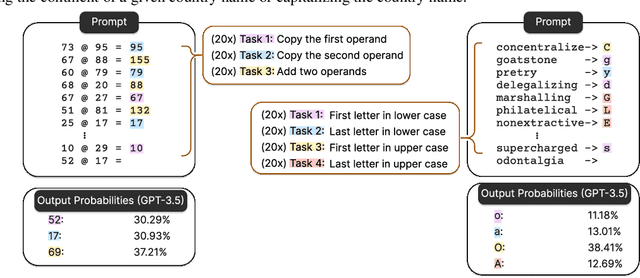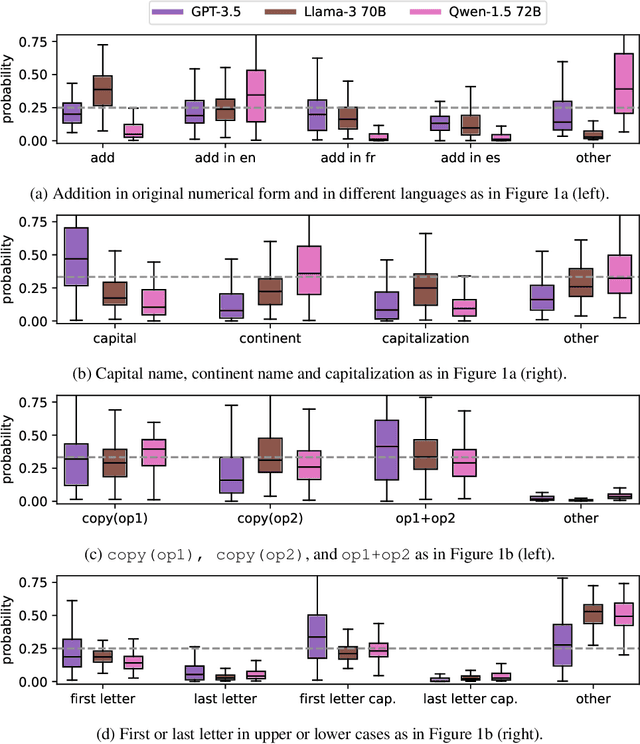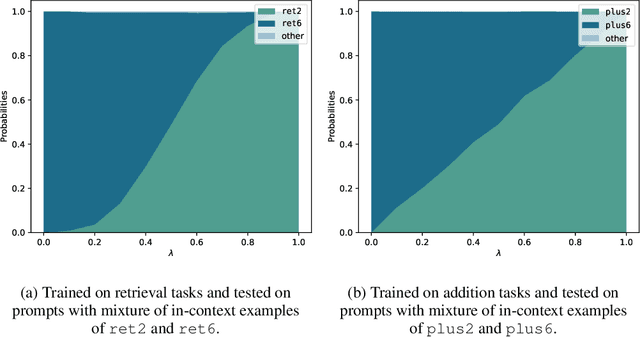Dimitris Papailiopoulos
VersaPRM: Multi-Domain Process Reward Model via Synthetic Reasoning Data
Feb 10, 2025



Abstract:Process Reward Models (PRMs) have proven effective at enhancing mathematical reasoning for Large Language Models (LLMs) by leveraging increased inference-time computation. However, they are predominantly trained on mathematical data and their generalizability to non-mathematical domains has not been rigorously studied. In response, this work first shows that current PRMs have poor performance in other domains. To address this limitation, we introduce VersaPRM, a multi-domain PRM trained on synthetic reasoning data generated using our novel data generation and annotation method. VersaPRM achieves consistent performance gains across diverse domains. For instance, in the MMLU-Pro category of Law, VersaPRM via weighted majority voting, achieves a 7.9% performance gain over the majority voting baseline -- surpassing Qwen2.5-Math-PRM's gain of 1.3%. We further contribute to the community by open-sourcing all data, code and models for VersaPRM.
Self-Improving Transformers Overcome Easy-to-Hard and Length Generalization Challenges
Feb 03, 2025Abstract:Large language models often struggle with length generalization and solving complex problem instances beyond their training distribution. We present a self-improvement approach where models iteratively generate and learn from their own solutions, progressively tackling harder problems while maintaining a standard transformer architecture. Across diverse tasks including arithmetic, string manipulation, and maze solving, self-improving enables models to solve problems far beyond their initial training distribution-for instance, generalizing from 10-digit to 100-digit addition without apparent saturation. We observe that in some cases filtering for correct self-generated examples leads to exponential improvements in out-of-distribution performance across training rounds. Additionally, starting from pretrained models significantly accelerates this self-improvement process for several tasks. Our results demonstrate how controlled weak-to-strong curricula can systematically teach a model logical extrapolation without any changes to the positional embeddings, or the model architecture.
Task Vectors in In-Context Learning: Emergence, Formation, and Benefit
Jan 16, 2025Abstract:In-context learning is a remarkable capability of transformers, referring to their ability to adapt to specific tasks based on a short history or context. Previous research has found that task-specific information is locally encoded within models, though their emergence and functionality remain unclear due to opaque pre-training processes. In this work, we investigate the formation of task vectors in a controlled setting, using models trained from scratch on synthetic datasets. Our findings confirm that task vectors naturally emerge under certain conditions, but the tasks may be relatively weakly and/or non-locally encoded within the model. To promote strong task vectors encoded at a prescribed location within the model, we propose an auxiliary training mechanism based on a task vector prompting loss (TVP-loss). This method eliminates the need to search for task-correlated encodings within the trained model and demonstrably improves robustness and generalization.
Lexico: Extreme KV Cache Compression via Sparse Coding over Universal Dictionaries
Dec 12, 2024



Abstract:We introduce Lexico, a novel KV cache compression method that leverages sparse coding with a universal dictionary. Our key finding is that key-value cache in modern LLMs can be accurately approximated using sparse linear combination from a small, input-agnostic dictionary of ~4k atoms, enabling efficient compression across different input prompts, tasks and models. Using orthogonal matching pursuit for sparse approximation, Lexico achieves flexible compression ratios through direct sparsity control. On GSM8K, across multiple model families (Mistral, Llama 3, Qwen2.5), Lexico maintains 90-95% of the original performance while using only 15-25% of the full KV-cache memory, outperforming both quantization and token eviction methods. Notably, Lexico remains effective in low memory regimes where 2-bit quantization fails, achieving up to 1.7x better compression on LongBench and GSM8K while maintaining high accuracy.
Everything Everywhere All at Once: LLMs can In-Context Learn Multiple Tasks in Superposition
Oct 08, 2024



Abstract:Large Language Models (LLMs) have demonstrated remarkable in-context learning (ICL) capabilities. In this study, we explore a surprising phenomenon related to ICL: LLMs can perform multiple, computationally distinct ICL tasks simultaneously, during a single inference call, a capability we term "task superposition". We provide empirical evidence of this phenomenon across various LLM families and scales and show that this phenomenon emerges even if we train the model to in-context learn one task at a time. We offer theoretical explanations that this capability is well within the expressive power of transformers. We also explore how LLMs internally compose task vectors during superposition. Furthermore, we show that larger models can solve more ICL tasks in parallel, and better calibrate their output distribution. Our findings offer insights into the latent capabilities of LLMs, further substantiate the perspective of "LLMs as superposition of simulators", and raise questions about the mechanisms enabling simultaneous task execution.
From Artificial Needles to Real Haystacks: Improving Retrieval Capabilities in LLMs by Finetuning on Synthetic Data
Jun 27, 2024



Abstract:Recent studies have shown that Large Language Models (LLMs) struggle to accurately retrieve information and maintain reasoning capabilities when processing long-context inputs. To address these limitations, we propose a finetuning approach utilizing a carefully designed synthetic dataset comprising numerical key-value retrieval tasks. Our experiments on models like GPT-3.5 Turbo and Mistral 7B demonstrate that finetuning LLMs on this dataset significantly improves LLMs' information retrieval and reasoning capabilities in longer-context settings. We present an analysis of the finetuned models, illustrating the transfer of skills from synthetic to real task evaluations (e.g., $10.5\%$ improvement on $20$ documents MDQA at position $10$ for GPT-3.5 Turbo). We also find that finetuned LLMs' performance on general benchmarks remains almost constant while LLMs finetuned on other baseline long-context augmentation data can encourage hallucination (e.g., on TriviaQA, Mistral 7B finetuned on our synthetic data cause no performance drop while other baseline data can cause a drop that ranges from $2.33\%$ to $6.19\%$). Our study highlights the potential of finetuning on synthetic data for improving the performance of LLMs on longer-context tasks.
CHAI: Clustered Head Attention for Efficient LLM Inference
Mar 12, 2024



Abstract:Large Language Models (LLMs) with hundreds of billions of parameters have transformed the field of machine learning. However, serving these models at inference time is both compute and memory intensive, where a single request can require multiple GPUs and tens of Gigabytes of memory. Multi-Head Attention is one of the key components of LLMs, which can account for over 50% of LLMs memory and compute requirement. We observe that there is a high amount of redundancy across heads on which tokens they pay attention to. Based on this insight, we propose Clustered Head Attention (CHAI). CHAI combines heads with a high amount of correlation for self-attention at runtime, thus reducing both memory and compute. In our experiments, we show that CHAI is able to reduce the memory requirements for storing K,V cache by up to 21.4% and inference time latency by up to 1.73x without any fine-tuning required. CHAI achieves this with a maximum 3.2% deviation in accuracy across 3 different models (i.e. OPT-66B, LLAMA-7B, LLAMA-33B) and 5 different evaluation datasets.
How Well Can Transformers Emulate In-context Newton's Method?
Mar 05, 2024Abstract:Transformer-based models have demonstrated remarkable in-context learning capabilities, prompting extensive research into its underlying mechanisms. Recent studies have suggested that Transformers can implement first-order optimization algorithms for in-context learning and even second order ones for the case of linear regression. In this work, we study whether Transformers can perform higher order optimization methods, beyond the case of linear regression. We establish that linear attention Transformers with ReLU layers can approximate second order optimization algorithms for the task of logistic regression and achieve $\epsilon$ error with only a logarithmic to the error more layers. As a by-product we demonstrate the ability of even linear attention-only Transformers in implementing a single step of Newton's iteration for matrix inversion with merely two layers. These results suggest the ability of the Transformer architecture to implement complex algorithms, beyond gradient descent.
Can Mamba Learn How to Learn? A Comparative Study on In-Context Learning Tasks
Feb 06, 2024Abstract:State-space models (SSMs), such as Mamba Gu & Dao (2034), have been proposed as alternatives to Transformer networks in language modeling, by incorporating gating, convolutions, and input-dependent token selection to mitigate the quadratic cost of multi-head attention. Although SSMs exhibit competitive performance, their in-context learning (ICL) capabilities, a remarkable emergent property of modern language models that enables task execution without parameter optimization, remain underexplored compared to Transformers. In this study, we evaluate the ICL performance of SSMs, focusing on Mamba, against Transformer models across various tasks. Our results show that SSMs perform comparably to Transformers in standard regression ICL tasks, while outperforming them in tasks like sparse parity learning. However, SSMs fall short in tasks involving non-standard retrieval functionality. To address these limitations, we introduce a hybrid model, \variant, that combines Mamba with attention blocks, surpassing individual models in tasks where they struggle independently. Our findings suggest that hybrid architectures offer promising avenues for enhancing ICL in language models.
Looped Transformers are Better at Learning Learning Algorithms
Nov 21, 2023Abstract:Transformers have demonstrated effectiveness in \emph{in-context solving} data-fitting problems from various (latent) models, as reported by Garg et al. However, the absence of an inherent iterative structure in the transformer architecture presents a challenge in emulating the iterative algorithms, which are commonly employed in traditional machine learning methods. To address this, we propose the utilization of \emph{looped} transformer architecture and its associated training methodology, with the aim of incorporating iterative characteristics into the transformer architectures. Experimental results suggest that the looped transformer achieves performance comparable to the standard transformer in solving various data-fitting problems, while utilizing less than 10\% of the parameter count.
 Add to Chrome
Add to Chrome Add to Firefox
Add to Firefox Add to Edge
Add to Edge